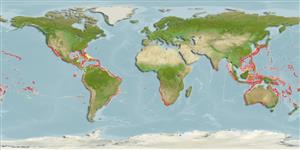Teleostei (teleosts) >
Scombriformes (Mackerels) >
Trichiuridae (Cutlassfishes) > Lepidopodinae
Etymology: Assurger: Latin, assurgero = to rise (Ref. 45335).
Environment: milieu / climate zone / depth range / distribution range
Ecology
Marine; benthopelagic; depth range 150 - 400 m (Ref. 6181). Tropical; 37°N - 37°S, 180°W - 180°E (Ref. 6181)
Atlantic Ocean: Walvis Ridge, off Puerto Rico and Uruguay. Indian Ocean: off western Australia. Pacific Ocean: off New Guinea, southern Japan, Midway Island, California, Nazca and Sala y Gomez Ridge.
Size / Weight / Age
Maturity: Lm ? range ? - ? cm
Max length : 250 cm SL male/unsexed; (Ref. 9351); common length : 200 cm SL male/unsexed; (Ref. 9351)
Dorsal soft rays (total): 116 - 123; Anal spines: 2; Anal soft rays: 74 - 87; Vertebrae: 125 - 129. Body very elongate and compressed. Head profile straight or scarcely convex, with sagittal crest strongly elevated. Both jaws have a short dermal process; the lower jaw longer than the upper jaw. The dorsal fin has a few weak anterior spines that hardly differ from the soft rays. Body color silvery, dorsal fin membrane black before the third to the fourth soft ray.
Probably benthopelagic from 150 to 400 m, juveniles epipelagic or mesopelagic. Feeds on fishes (including Engraulis mordax and Merluccius productus off California) and squids. Occasionally hooked, captured in nets, or found washed ashore. No special fishery.
Life cycle and mating behavior
Maturity | Reproduction | Spawning | Eggs | Fecundity | Larvae
Nakamura, I. and N.V. Parin, 1993. FAO Species Catalogue. Vol. 15. Snake mackerels and cutlassfishes of the world (families Gempylidae and Trichiuridae). An annotated and illustrated catalogue of the snake mackerels, snoeks, escolars, gemfishes, sackfishes, domine, oilfish, cutlassfishes,. scabbardfishes, hairtails, and frostfishes known to date. FAO Fish. Synop. 125(15):136 p. (Ref. 6181)
IUCN Red List Status (Ref. 130435: Version 2024-2)
Threat to humans
Harmless
Human uses
Fisheries: subsistence fisheries
Tools
Special reports
Download XML
Internet sources
Estimates based on models
Preferred temperature (Ref.
123201): 10 - 20.6, mean 14.7 °C (based on 279 cells).
Phylogenetic diversity index (Ref.
82804): PD
50 = 1.0000 [Uniqueness, from 0.5 = low to 2.0 = high].
Bayesian length-weight: a=0.00052 (0.00021 - 0.00129), b=3.13 (2.92 - 3.34), in cm total length, based on LWR estimates for this (Sub)family-body shape (Ref.
93245).
Trophic level (Ref.
69278): 4.5 ±0.69 se; based on food items.
Resilience (Ref.
120179): Low, minimum population doubling time 4.5 - 14 years (Preliminary K or Fecundity.).
Fishing Vulnerability (Ref.
59153): Very high vulnerability (90 of 100).
Nutrients (Ref.
124155): Calcium = 38.5 [17.7, 76.0] mg/100g; Iron = 0.632 [0.313, 1.202] mg/100g; Protein = 17.7 [16.1, 19.3] %; Omega3 = 0.147 [0.071, 0.331] g/100g; Selenium = 142 [65, 340] μg/100g; VitaminA = 15 [4, 53] μg/100g; Zinc = 0.578 [0.385, 0.925] mg/100g (wet weight);
